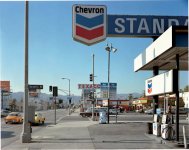nightfly
Well-known
I'm looking to get an approximation of the type of color of Stephen Shore's Uncommon Places, that sort of low saturation, vintage look either with film, post processing or straight digital, whatever works.
I realize his was a product of large format and the materials of that time. I'm looking to do it in either 35mm or digital or 120 if necessary. Basically whatever works.
Any suggestions for film stock or digital recipes?
I realize his was a product of large format and the materials of that time. I'm looking to do it in either 35mm or digital or 120 if necessary. Basically whatever works.
Any suggestions for film stock or digital recipes?









